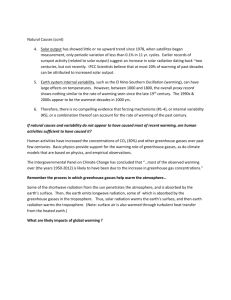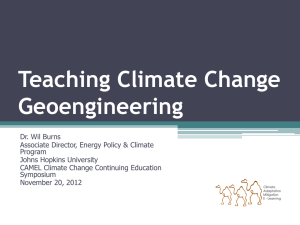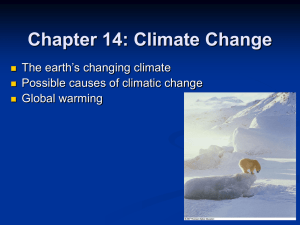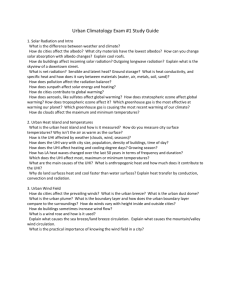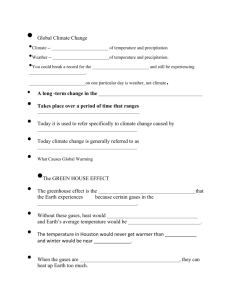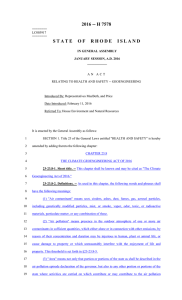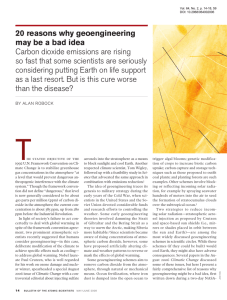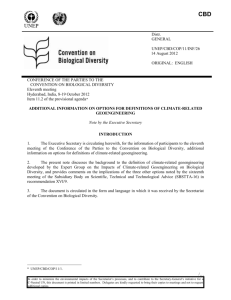Solar Radiation Management Essay
advertisement
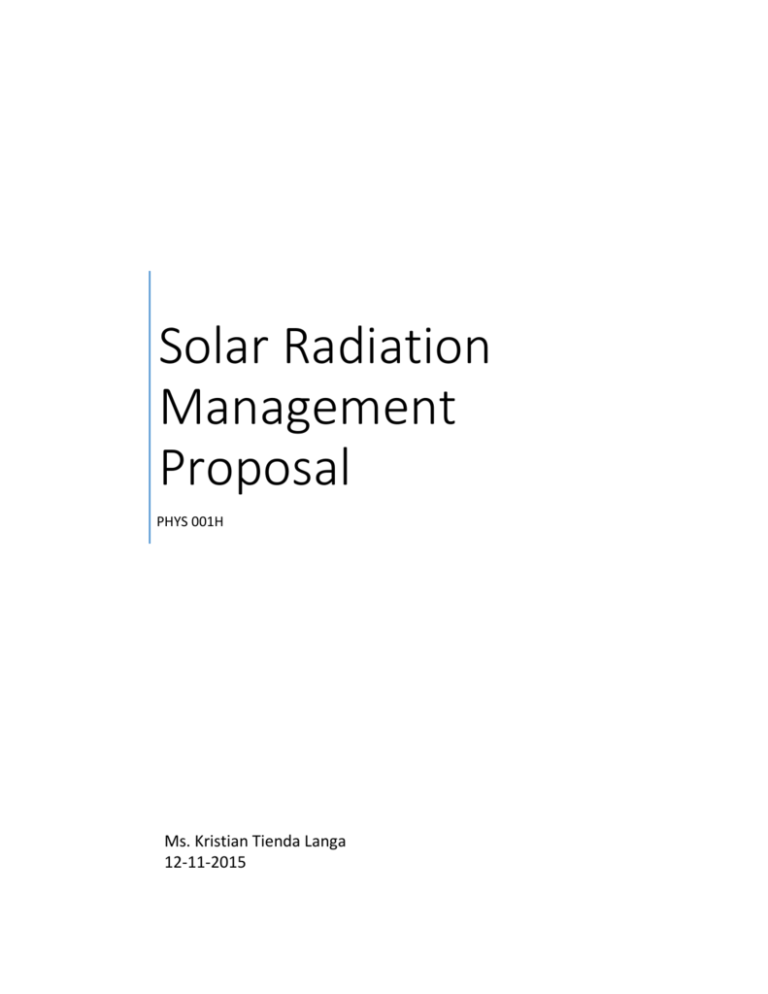
Solar Radiation Management Proposal PHYS 001H Ms. Kristian Tienda Langa 12-11-2015 Kristian Langa Tienda December 11th, 2015 Dr. Takahashi End of Semesters Presentation Solar Radiation Management Global Warming. The words solicit a plethora of images and ideas in many individual’s mind. The words create a large polarization in even political parties, where the more liberal parties advocate defeating global warming, while most conservatives disagree with global warming’s existence. Global warming was even a pivotal point for popular vote winner Al Gore. Global warming creates the idea of a planet warming up faster than it is supposed to, due to human error. The public is divided in the debate if global warming, or climate change as most scientist call it, is occurring, or if human have any involvement in this global change. Science states the planet is warming at a greater rate than deemed normal, which correlates with an increase of CO2 and other damaging human altercations that started during the Industrial Revolution, as Svante Arrhenius started discovering in the early 1900s. Because of this increase in temperature that is occurring, the majority of society is concerned about what will happen to planet earth. The scientist and governments concerned about this climate change are finding ways to either slow the process or decrease it through many means including Solar Radiation Management. Solar Radiation management has been deemed the “Fast & Cheap” solution to climate change. Solar Radiation Management uses the sciences of many disciplines, specifically geoengineering. Geoengineering is the “the intentional large-scale manipulation of the global environment” (Geoengineering, 1). Climate geoengineering technologies can be divided into three broad areas: so-called solar radiation management (reflecting sunlight to space), greenhouse gas removal and sequestration and weather modification. SRM, or Solar Radiation Management is the route of geoengineering government’s prefer. Solar Radiation Management comprises various methods that aim at reflecting/diverting solar radiation back into space, essentially increasing the planet’s albedo (reflectivity of light, lower in summer, higher in winter with snowfall). This form of geoengineering is what the future will most likely use as a quick fix to the SRM-Carbon complex. As documented by several scientist like David Keith, carbon pollution has been one of the largest contributions to the climate change occurring now. Large amounts of carbon is causing a thinning in the ozone, one of the layers of atmospheres that filters ultraviolet light, and gradual temperature rise of the planet. The federal government prefers SRM to reducing carbon because of many reasons including: the difficulty of reducing carbon outputs in the world, the carbon cycle complexity, and the economic efficiency. Due to this demand, several scientist have started research to give the government the best solution, which is believed to be the first major steps towards combating climate change. Right now many projects are being put forward, and many more will come. Solar Radiation Management has created the drive for several projects in the scientific community. Stratospheric Aerosols are currently being marketed by Harvard Prof. David Keith, who wants to inject aerosol particles of sulfur spray into the air that would reflect light. Keith has advertised the idea to media outlets like PBS where he was part of an interview explaining that “It’s certainly not a solution if by solution you mean that solar geoengineering is the only thing that could be done. If you do not bring the emissions of carbon at the atmosphere to zero, you can’t have a stable climate. It’s really as simple as that” (PBS Newshour). Keith aims to dispel the dramatic media of global warming and be blunt to the public about his temporary fix. Another project created was the idea of Space Mirrors. Arizona State Prof. Roger Angel proposed that these mirrors were to be put into orbit around the earth and would deflect some solar sunlight into space. As Brian Schmidt of the Australian National University in Canberra said, "Roger's always been someone who has lots of wild ideas; some of them are superb, some of them probably not so good. But he's incredibly creative,” (NPR Telescope Innovator Shines His Genius On New Fields). As Schmidt predicted, Angel’s efforts have not advanced as far as the Professor had wished and is not the front running project of Solar Radiation Management. Moon Dust, another project put forth, was instigated by Iowa State Prof. Curtis Struck, who proposed mining the dust on the moon to create a shielding cloud that would block out radiation. Cambridge Prof. Hugh Hunt set a aluminized hydrogen-filled balloon into space as a reflective screen. Prof. Stephen Salter and Dr. John Latham propose spraying seawater in the atmosphere to increase the reflectiveness of clouds, blocking light, causing their idea of cloud reflectivity. The idea of reflective sheeting, the adding of reflective plastic sheets covering 67,000 mi2 of desert each year between 2010-2070, has been proposed in order to reflect the Sun’s energy (Zion Light). Crops and Agriculture have been pitched to play a role to. Through bioengineering, crops can be genetically engineered to have higher albedo (reflectivity), in order to reflect more ultraviolet light back into the atmosphere. Several more known projects are being proposed to the Royal Society and National Research Council currently, are being discussed right not in the Paris World Climate Summit, where the positives and negatives are being weighed. Controversies occur in every field of science, including the SRM sect of geoengineering. Some individuals in society fear chemtrails, which a visible trail left in the sky by an airplane or military aircraft. Concerns range from the idea that they could exacerbate global warming to conspiracies that the government has secretly been dumping harmful substances on the land, poisoning the American public. Others believe that the government is pumping money into these quick fixes that Dr. David Keith admits are, without taking the time and money on more reliable and long term solutions. People believe that the government rather invest in this than decrease CO2 emissions, due to greedy congressman and a damaging economic blow. Some see engineering nature is not our place. Humans have already messed with Earth enough or the Earth is on its natural course and that altering the earth in any way could disturb the natural order or accelerated order occurring now. In relation to the conspiracy of harmful chemicals in chemtrails, these solutions are believed to possibly harm the atmosphere, such as Stratospheric Aerosols that spray more sulfur into the ozone. Greater sulfur could induce an issue in the sulfur cycle, and not enough research can show the lasting effects. Many oppositions must be addressed and looked through before any Solar Radiation Management program could ever be implemented. Though there is much controversy over any Solar Radiation Management plan, a ‘BandAid’ is what is necessary for the current situation happening. Twelve chunks of icebergs are currently melting near the Paris World Climate Summit, designed by artist Dercy, so that the urgency is made known to the officials attending the summit. Solar Radiation Management is going to be one of the only measures that the government will be willing to take any time soon due to a stubborn economic and social base. McClellan measured that only $2-8 Billion would be needed to fund whichever project the governance of the globe wishes to push forward, which compared to the $10 Billion our governments spends each day, is peanuts. Less than one day of spending going towards a proactive cause is worth the opportunity cost. Though long terms plans must be drafted, and CO2 emissions must be dramatically curtailed, SRM projects are the best key to decrease further increase in the earth’s temperature, which can cause catastrophic ecological and meteorological events. While these programs are being implemented, further negotiations and scientific research can be focused on a long term goal. Though right now, before we can have accurate treatment, we need to stop the bleeding. Work Cited McClellan, Justin, James Sisco, Brandon Suarez, and Greg Keogh. "Cost Analysis." Springer Reference (2011): 1-87. Aurora Flight Sciences Corporation, 27 July 2011. Web. 9 Dec. 2015. Jones, Nicola. "Solar Geoengineering: Weighing Costs of Blocking the Sun's Rays." By Nicola Jones: Yale Environment 360. Yale, 9 Jan. 2014. Web. 7 Dec. 2015. Cleetus, Rachael, Adam Markham, Alden Meyer, and Erika Spanger-Siegfried. "Global Warming." Union of Concerned Scientists. Union of Concerned Scientist, 2015. Web. 9 Dec. 2015 Keith, David. "Introduction." Introduction. Geoengineering. Dordrecht: Springer, 2006. 1. Print. Keith, David. "A Cheap but Dangerous Global Warming Fix." PBS. PBS, 16 July 2015. Web. 10 Dec. 2015. Palca, Joe. "Telescope Innovator Shines His Genius On New Fields." NPR. NPR, 23 Aug. 2012. Web. 8 Dec. 2015. Lights, Zion. "An Overview of Geoengineering | Permaculture Magazine." An Overview of Geoengineering | Permaculture Magazine. Hyden House Ltd, 2012. Web. 9 Dec. 2015.
